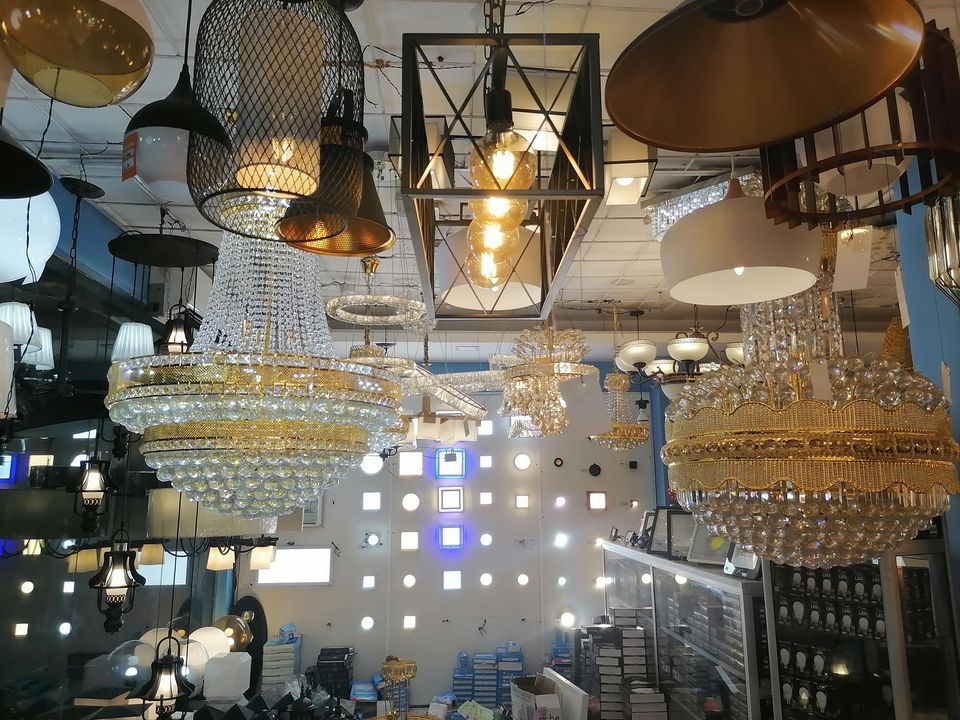Embarking on a journey to find the perfect light fixtures for your home or office can be overwhelming due to the myriad of options available at lighting shops. From chandeliers and pendant lights to recessed lighting and wall sconces, there are numerous factors to consider when selecting the ideal illumination for your space. To help guide you through this process, we’ve compiled a comprehensive list of essential tips that will ensure a smooth and successful visit to lighting stores.
Few Tips for Choosing Lights at Lighting Shop
#1. Get Familiar with the Types of Lighting Fixtures: Before diving into the world of lighting stores, it’s essential to familiarize yourself with the different types of light fixtures, including but not limited to:
- Chandeliers: A decorative hanging fixture with branches for multiple lights, often used for ambient lighting in dining areas, foyers and living spaces.
- Pendant Lights: Suspended from the ceiling, these lights provide focused illumination and can be used over kitchen islands, dining tables or entryways.
- Flush Mount Lights: Installed directly to the ceiling, flush mount lights are suitable for lower ceiling spaces, providing general illumination throughout the room.
- Recessed Lighting: These lights are installed into the ceiling, making them ideal for task or accent lighting without interrupting the overall aesthetics of your space.
- Wall Sconces: Installed on the wall, sconces add a touch of accent lighting to any room while enhancing its decor.
- Track Lighting: A versatile option that uses multiple adjustable heads, allowing for targeted illumination in areas where it’s needed the most.
- Floor Lamps: Portable and adjustable, floor lamps can be positioned to provide task or ambient lighting where necessary.
- Table Lamps: Perfect for desks or bedside tables, table lamps cater to specific tasks, such as reading or working.
#2. Understand the Purpose and Functionality of the Lights: Having a clear understanding of the purpose and functionality of the lights you require will further assist you in choosing the perfect fixtures. Figure out the primary function your light will serve, whether it’s ambient (general), task (focused), or accent (decorative) lighting. This will guide you in selecting the right intensity, direction, and style of lighting that’ll work best for your space.
#3. Research the Different Types of Bulbs and Their Features: Different types of light bulbs not only vary in terms of energy efficiency and lifespan but also impact the overall ambiance and temperature of your space. Common types of bulbs include incandescent, halogen, fluorescent, and LED, each offering varying degrees of color temperature and brightness. Make sure to research the compatibility of your chosen fixtures with the different types of bulbs.

#4. Consider Light Temperature and Color Rendering Index (CRI): Light temperature, measured in Kelvin (K), indicates the color of the light emitted by a bulb. Lower temperatures (2700K-3000K) emit warm and yellowish hues, while higher temperatures (5500K-6500K) produce cool and bluish tones. To ensure a cohesive look throughout your space, aim to maintain consistency in your selected color temperature by using bulbs with similar temperature ranges.
The Color Rendering Index (CRI) reflects how accurately a light source can reveal the true colors of objects, with a higher CRI ensuring better color perception. Therefore, selecting a bulb with a high CRI will benefit areas with high visual demands, such as art studios or galleries.
#5. Take Accurate Room Measurements and Plan the Layout: Before visiting lighting shop, measure the room and document the dimensions, ceiling height, and locations of any switch or wall outlets. This information will help you select the right-sized fixtures and determine the ideal spacing and position of your lighting based on your specific layout.
#6. Set a Realistic Budget: Lighting can be a costly investment, so establishing a budget beforehand will help you avoid overspending, ensuring that you allocate funds for proper installation and maintenance costs. Balance between aesthetics and practicality, opting for a fixture that suits your taste without compromising functionality.
#7. Pay Attention to Energy Efficiency: Environmentally friendly, energy-efficient lighting options not only benefit the planet but also translate into long-term cost savings. LED lighting is a popular choice, as it consumes less power and boasts a longer lifespan compared to traditional bulbs.
#8. Keep Aesthetics and Compatibility in Mind: When selecting fixtures and bulbs, consider their impact on the overall aesthetic of your space. Lighting should complement your existing décor and architectural features, creating a cohesive look that enhances the ambiance of your home or office.
#9. Consult with Experts in the Lighting Industry: For more personalized advice and guidance, don’t hesitate to consult with experts in the lighting industry. They can provide valuable insights on current trends and offer tailored suggestions based on your specific needs and preferences.
#10. Look for Proper Installation and Warranty Services: Prioritize lighting shops that offer professional installation services, as well as an extensive warranty period. Ensuring the proper installation of your light fixtures is crucial for their functionality and lifespan, and a comprehensive warranty coverage will provide you with peace of mind.
Conclusion
In conclusion, navigating the world of lighting stores can be an overwhelming task, but keeping these essential tips in mind will make the process of selecting the perfect lighting fixtures for your home or office a breeze. From understanding the purpose and functionality of the lights to ensuring proper installation and warranty services, these guidelines will ensure that you find the ideal illumination for your space while maintaining a balance of aesthetics, budget, and energy efficiency.

